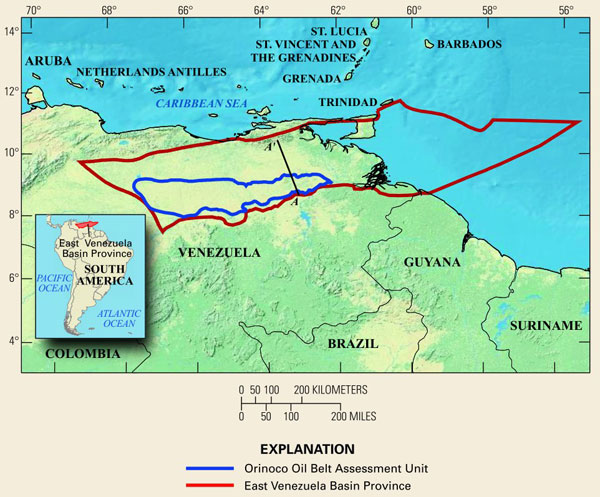An estimated 513 billion barrels of “technically recoverable” heavy oil lie in Venezuela’s Orinoco Oil Belt, a 50,000 square kilometre region in the East Venezuela Basin Province.
Worldwide consumption of petroleum was 85.4 million barrels per day in 2008. The three largest consuming countries were United States with 19.5 million barrels per day, China with 7.9 million barrels per day, and Japan with 4.8 million barrels per day. So the Venezuelan heavy oil represents a potential supply that could last a decade at the current rate of consumption.
The United States Geological Survey (USGS) has carried out the first assessment that identifies how much oil might be technically recoverable using currently technology and standard industry practices. According to USGS Energy Resources Program Coordinator Brenda Pierce, this part of the world has one of the world’s largest recoverable oil accumulations. The USGS’s report is part of its program directed at estimating the technically recoverable oil and gas resources of priority petroleum basins worldwide. This is the largest accumulation ever assessed by the USGS.
“Knowing the potential for extractable resources from this tremendous oil accumulation, and others like it, is critical to our understanding of the global petroleum potential and informing policy and decision makers,” explains Pierce. “Accumulations like this one were previously very difficult to produce, but advances in technology and new understandings in geology allow us to assess how much is now technically recoverable.”
USGS team member and a co-author of the report, Christopher Schenk explains further: “Heavy oil is a type of oil that is very thick and therefore does not flow very easily. As a result, specialized production and refining processes are needed to generate petroleum products, but it is still oil and can generate many of the same products as other types of oil.”
The estimated petroleum resources in the Orinoco Oil Belt, range from 380 to 652 billion barrels of oil (at a 95 and 5 percent chance of occurrence, respectively). Schenk says that the estimates are based on a rate of oil recovery of between 40 and 45 percent.
However, others are sceptical that these oil reserves are economically or environmentally viable. Venezuelan oil geologist Gustavo Coronel told the Associated Press that he doubted the recovery rate could be much higher than 25 percent given the nature of the crude oil. More intriguing is that the USGS announcement seems to have been timed to coincide with an international auction for drilling rights in the Orinoco Belt which took place on 28th January, with results to be announced on 10th February.
Moreover, there are no little energy and environmental costs to be considered in recovering heavy crude oil as it is not necessarily as easy to extract as conventional crude oil. Moreover, the existence of such reserves while perhaps saving us from short-term oil shortages does not address the issues of carbon emissions and potential climate change.
Links
USGS Assessment
http://pubs.usgs.gov/fs/2009/3028/
Energy Resources Program
http://energy.usgs.gov/
Auction news
http://www.reuters.com/article/idUSTRE60S5D320100129
Crude claims
http://rawstory.com/2010/01/usgs-claims-venezuela-holds-earths-largest-oil-reserves/
AP report
http://ca.news.finance.yahoo.com/s/22012010/2/biz-finance-venezuela-s-orinoco-area-holds-vast-supply-crude.html
